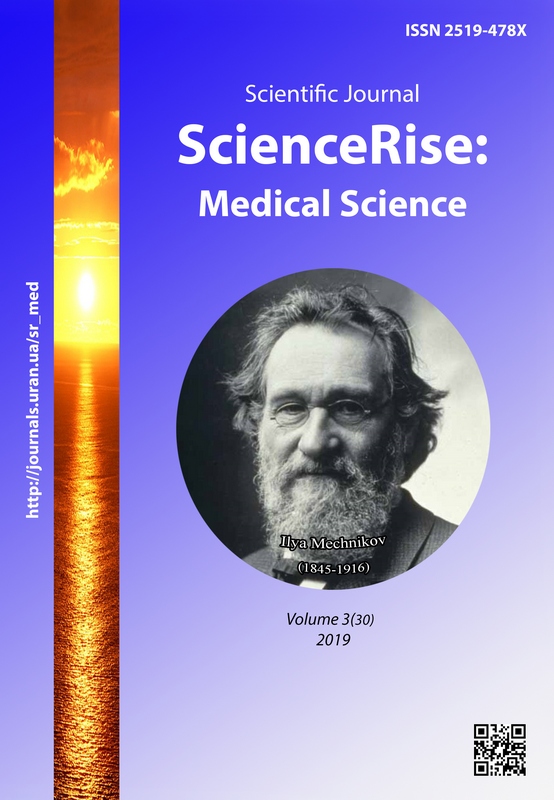Прогнозування розвитку артеріальної гіпотензії при повороті пацієнта на живіт на фоні спінальної анестезії
DOI:
https://doi.org/10.15587/2519-4798.2019.169496Ключові слова:
спінальна анестезія, гемодинаміка, положення на животі, поперековий відділ хребтаАнотація
При проведенні спінальної анестезії (СА) в положенні на животі може виникати артеріальна гіпотензія, що зумовлена як анестезією, так і впливом самого положення на кровообіг. Метою дослідження була розробка прогностичної моделі змін гемодинаміки при вертебрологічних операціях в положенні на животі в умовах спінальної анестезії.
Матеріал та методи дослідження. Вивчені постуральні реакції кровообігу у 144 пацієнтів ортопедичного профілю, що були оперовані в положенні на животі під спінальною анестезією: в положенні на спині, через 5 та через 20 хвилин після повороту на живіт. Попередньо (за добу до операції) досліджені ті ж самі реакції без анестезії.
Результати. У 16,0±3,1 % пацієнтів під час СА була необхідна корекція гемодинаміки α1-адреноміметиками після повороту на живіт. Ректроспективний аналіз змін гемодинаміки до та під час анестезії виявив у цих пацієнтів напруження компенсації кровообігу, що проявлялось при повороті на живіт без анестезії у артеріальній гіпертензії та підвищенні загального периферичного судинного опору. Під впливом СА ця компенсація пригнічувалась, що призводило до нестабільності кровообігу. Значний ризик такого ускладнення мав місце у пацієнтів молодшого віку та із підвищеним ІМТ. За результатами ретроспективного аналізу розроблена математична модель, що дозволяє розрахувати прогностичний індекс нестабільності гемодинаміки (ПІНГ) та передбачити нестабільність гемодинаміки під час СА при положенні хворого на животі. Величина ПІНГ може варіювати від нескінченно малої величини до 1.
Висновки: перед проведенням оперативних втручань в положенні на животі під СА доцільно передопераційне вивчення постуральних реакцій кровообігу з розрахунком ПІНГ. При ПІНГ > 0,5 слід відмовитись від проведення СА та обрати інший вид анестезії
Посилання
- Edgcombe, H., Carter, K., Yarrow, S. (2008). Anaesthesia in the prone position. British Journal of Anaesthesia, 100 (2), 165–183. doi: http://doi.org/10.1093/bja/aem380
- Lessing, N. L., Edwards, C. C., Brown, C. H., Ledford, E. C., Dean, C. L., Lin, C., Edwards, C. C. (2016). Spinal Anesthesia in Elderly Patients Undergoing Lumbar Spine Surgery. Orthopedics, 40 (2), e317–e322. doi: http://doi.org/10.3928/01477447-20161219-01
- Chinachoti, T., Tritrakarn, Т. (2007). Prospective study of hypotension and bradycardia during spinal anesthesia with bupivacaine: incidence and risk factors, part two. Journal of the Medical Association of Thailand, 90 (3), 492–501.
- Bible, J. E., Mirza, M., Knaub, M. A. (2018). Blood-loss Management in Spine Surgery. Journal of the American Academy of Orthopaedic Surgeons, 26 (2), 35–44. doi: http://doi.org/10.5435/jaaos-d-16-00184
- Ławicka, M., Małek, A., Antczak, D., Wajlonis, A., Owczuk, R. (2015). Non-invasive haemodynamic measurements with Nexfin predict the risk of hypotension following spinal anaesthesia. Anestezjologia Intensywna Terapia, 47 (4), 303–308. doi: http://doi.org/10.5603/ait.2015.0048
- Wu, C.-Y., Lee, T.-S., Chan, K.-C., Jeng, C.-S., Cheng, Y.-J. (2012). Does targeted pre-load optimisation by stroke volume variation attenuate a reduction in cardiac output in the prone position. Anaesthesia, 67 (7), 760–764. doi: http://doi.org/10.1111/j.1365-2044.2012.07116.x
- Filho, G., Garcia, J., Goldschimidt, R., Mago, A., Cordeiro, M., Ceccato, F. (2001). Predictors of early hypotension during spinal anesthesia. Revista Brasileira de Anestesiologia, 51 (4), 298–304. doi: http://doi.org/10.1590/s0034-70942001000400004
- Sakata, K., Yoshimura, N., Tanabe, K., Kito, K., Nagase, K., Iida, H. (2017). Prediction of hypotension during spinal anesthesia for elective cesarean section by altered heart rate variability induced by postural change. International Journal of Obstetric Anesthesia, 29, 34–38. doi: http://doi.org/10.1016/j.ijoa.2016.09.004
- Behunov, A. A., Shyhaev, M. Yu., Shyhaev, Yu. H. (2010). Pat. No. 2383298 RU. Sposob prognozirovanija potrjebnosti korrekcii gemodinamiki pri provedenii regionarnoi anestesii s klofelinom [Prognostic Method of Requirements of Hemodynamic Correction During Regional Anesthesia with Clonidine]. МPK: А61В 5/02, А61М 19/00, А61К31/4168, А61P 9/02. No. 2008142334/14; declareted: 24.10.2008; published: 10.03.2010.
- Lyzohub, M. V., Georgiyants, M. A., Vysotska, O. V., Porvan, A. P., Lyzohub, K. I. (2019). Pat. No. 131991 UA. Sposib prognozuvannja nespryiatlyvyh zmin hemodynamiky na phoni spinalnoii anesthesiii [Prognostic method of unfavourable hemodynamic changes during spinal anesthesia]. MPK: А61В 5/02. No. u 2018 08333; declareted: 30.07.2018; published: 11.02.2019, Bul. No. 3.
- Shimizu, M., Fujii, H., Yamawake, N., Nishizaki, M. (2015). Cardiac function changes with switching from the supine to prone position: Analysis by quantitative semiconductor gated single-photon emission computed tomography. Journal of Nuclear Cardiology, 22 (2), 301–307. doi: http://doi.org/10.1007/s12350-014-0058-3
- Tabara, Y., Tachibana-Iimori, R., Yamamoto, M., Abe, M., Kondo, I., Miki, T., Kohara, K. (2005). Hypotension Associated with Prone Body Position: A Possible Overlooked Postural Hypotension. Hypertension Research, 28 (9), 741–746. doi: http://doi.org/10.1291/hypres.28.741
- Hofhuizen, C., Lemson, J., Snoeck, M., Scheffer, G.-J. (2019). Spinal anesthesia-induced hypotension is caused by a decrease in stroke volume in elderly patients. Local and Regional Anesthesia, 12, 19–26. doi: http://doi.org/10.2147/lra.s193925
##submission.downloads##
Опубліковано
Як цитувати
Номер
Розділ
Ліцензія
Авторське право (c) 2019 Mykola Lyzohub, Marine Georgiyants, Olena Visotska, Kostiantyn Mykhnevych, Andrii Porvan

Ця робота ліцензується відповідно до Creative Commons Attribution 4.0 International License.
Наше видання використовує положення про авторські права Creative Commons CC BY для журналів відкритого доступу.
Автори, які публікуються у цьому журналі, погоджуються з наступними умовами:
1. Автори залишають за собою право на авторство своєї роботи та передають журналу право першої публікації цієї роботи на умовах ліцензії Creative Commons CC BY, котра дозволяє іншим особам вільно розповсюджувати опубліковану роботу з обов'язковим посиланням на авторів оригінальної роботи та першу публікацію роботи у цьому журналі.
2. Автори мають право укладати самостійні додаткові угоди щодо неексклюзивного розповсюдження роботи у тому вигляді, в якому вона була опублікована цим журналом (наприклад, розміщувати роботу в електронному сховищі установи або публікувати у складі монографії), за умови збереження посилання на першу публікацію роботи у цьому журналі.










